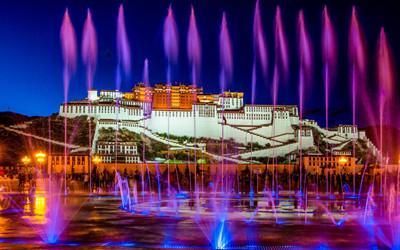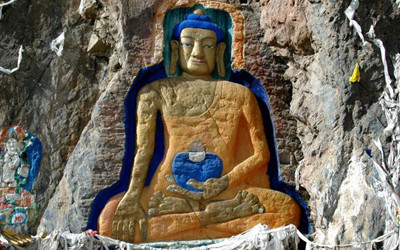Skype: neodalle-travel
Tel: +86 135 7447 2266
E-mail: sales@visitaroundchina.com

Songtsen Gampo embraced the religion and the first transmission of Buddhism came to the snowy land. The king and the princesses built Jokhang Temple and Ramoche Temple to enshrine the holy statues of Sakyamuni. They also ordered the construction of the grand Potala Palace. The king's successors followed the religion too and in 779 King Trisong Detsen set up Samye Monastery, the first Buddhist temple on this land. The great religious teacher, Padmasambhava was invited there and Buddhism was recognized as the state religion. The Buddhist influence spread as the expansion of the Tibetan empire continued. The indigenous Bon were not satisfied with the popularity that Buddhism held with the royal family. In 836, King Ralpachen was assassinated and Lang Darma , who believed in Bon and objected to Buddhism, was installed as King. Severe persecution against Buddhists ended the first Buddhism transmission. Lang Darma, in 842, was assassinated by a Buddhist and the collapse of the Yarlong Dynasty followed causing the decentralization of the region and a struggle for power for the next 400 years.
 In 1042, Atisa was invited to the land to launch the second Buddhism transmission and Buddhism gradually revived. Gradually, Tibetan Buddhism divided itself into many sects and sub-sects, which rigorously debated with each other, vying for dominance by seeking patrons among the warring principalities. In the twelfth century, the Mongol Empire rose to power and expanded aggressively. Sakyapa, or the Stripe sect, was quite powerful among all the sects at that time. The Mongol Emperor negotiated with the abbot of Sakyapa and assisted him to become the ruler of the land. From then on, the region became an appendage of the Mongol Empire. Later, the Mongol Empire conquered the Song Dynasty (960-1279) and founded the Yuan Dynasty (1271-1368). In 1254, Kublai Khan granted supreme authority over the snowy land to the leader of Sakyapa. Sakya Pandit was appointed to become the imperial preceptor and a high official in his court. The area was thus incorporated as one of the 13 provinces of China. At the end of the Yuan Dynasty, Sakyapa declined and was replaced by the Kagyu order, whose patron offered tribute to the imperial court and was conferred with titles and administrative authority. After the Ming Dynasty (1368-1644) was established, high lamas there were summoned to the imperial court to receive titles and appointments.
In 1042, Atisa was invited to the land to launch the second Buddhism transmission and Buddhism gradually revived. Gradually, Tibetan Buddhism divided itself into many sects and sub-sects, which rigorously debated with each other, vying for dominance by seeking patrons among the warring principalities. In the twelfth century, the Mongol Empire rose to power and expanded aggressively. Sakyapa, or the Stripe sect, was quite powerful among all the sects at that time. The Mongol Emperor negotiated with the abbot of Sakyapa and assisted him to become the ruler of the land. From then on, the region became an appendage of the Mongol Empire. Later, the Mongol Empire conquered the Song Dynasty (960-1279) and founded the Yuan Dynasty (1271-1368). In 1254, Kublai Khan granted supreme authority over the snowy land to the leader of Sakyapa. Sakya Pandit was appointed to become the imperial preceptor and a high official in his court. The area was thus incorporated as one of the 13 provinces of China. At the end of the Yuan Dynasty, Sakyapa declined and was replaced by the Kagyu order, whose patron offered tribute to the imperial court and was conferred with titles and administrative authority. After the Ming Dynasty (1368-1644) was established, high lamas there were summoned to the imperial court to receive titles and appointments.
In 1644, Qing Dynasty replaced Ming Dynasty. In 1652, the Fifth Dalai Lama was summoned to Beijing, and in 1653 he was conferred with the title Dalai Lama and made religious leader of local Buddhism by Emperor Shunzhi (1643 - 1661). In 1727, the central government of the Qing Dynasty sent ministers there as a representative to supervise local administration. The boundary of Tibet and Sichuan, Yunnan, and Qinghai was then official set. The Qing government promulgated Imperially Approved Ordinance for the More Efficient Governing of Tibet concerning many issues such as the duty of representative ministers, boundary military defense, finance, tax and the management of the temples etc in 1793. Since then, the major principles of the ordinance worked as the regulation for local regime and legislation for more than a century.
In 1911, the Qing Dynasty collapsed and the Republic of China was founded. The government of Republic of China practiced the sovereignty of the area just as the Yuan, Ming and Qing Dynasties did. The central government set Mongolia and Tibet affair office and commission to execute the administration of Tibet nationality, Mongolia nationality as well as other minorities. In 1949, the People's Republic of China was founded. The PRC government adopted the policy of peace liberation and signed with local government the Seventeenth Point Treaty. Later in 1959, Chinese government carried out a democratic reform of abolishing feudal serf system so that hundreds of thousands of serfs and slaves were free and no longer forced to labor.
With a steady development of the next several years, the Tibet Autonomous Region was officially founded in September, 1965. Up to now, this splendid pure land has received numerous visitors from all over the world ever since it is opened to the outside world.
 Ask Questions ?
Ask Questions ?